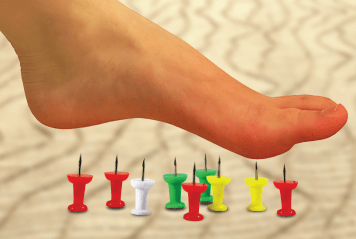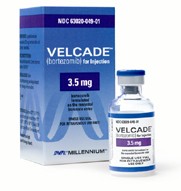
Recently Diagnosed or Relapsed? Stop Looking For a Miracle Cure, and Use Evidence-Based Therapies To Enhance Your Treatment and Prolong Your Remission
Multiple Myeloma an incurable disease, but I have spent the last 25 years in remission using a blend of conventional oncology and evidence-based nutrition, supplementation, and lifestyle therapies from peer-reviewed studies that your oncologist probably hasn't told you about.
Click the orange button to the right to learn more about what you can start doing today.
- You are here:
- Home »
- Blog »
- Multiple Myeloma »
- Multiple Myeloma- Bortezomib-Induced Peripheral Neuropathy (BIPN)
Multiple Myeloma- Bortezomib-Induced Peripheral Neuropathy (BIPN)

“Peripheral neuropathy is a common and important nonhematologic, dose-limiting adverse effect (for MM) of bortezomib-based chemotherapy…”
From ’94-’97 I underwent chemotherapy and radiation to treat my newly diagnosed multiple myeloma (MM). Over a period of years, I developed the adverse event aka side effect called peripheral neuropathy, documented below in the linked and excerpted studies.
Since I did not undergo bortezomib (Velcade) I don’t refer to my nerve damage as Bortezomib-Induced Peripheral Neuropathy (BIPN)- I just tell people that I have “nerve damage” from chemotherapy and radation.
Nerve damage is a prevelant side effect for cancer patients in general and for MM patients in particular.
Many different chemotherapy regimens can cause nerve damage. Radiation can cause nerve damage. Nerve damage is perhaps the most insidious of all long-term side effects because the MM patient is helpless to manage this adverse event in any meaningful way.
Specifically:
- Nerve damage is not well-understood by oncology-there are few if any effective treatment therapies
- Nerve damage often worsens over a period of years
- The patient often will not realize the eventual severity of this side effect
Conventional oncology leads multiple myeloma patients to believe that if they experience nerve damage from bortezomib/velcade that they will heal. The studies below document the opposite. Most patients will find their nerve damage worsening in the coming years. This is what happended to me.
The point of this blog post is
- to document this side effect and
- to document what you can do
The list of therapies includes everything from HBOT, to several conventional medicines to physical therapy as well as integrative therapies shown to reduce the toxicity of chemotherapy and radiation. Please read the blog posts in the “Recommended Reading” section below.
I am both a long-term survivor of multiple myeloma and a MM cancer coach. If you would like more specific information about CIPN, BIPN or RILP scroll down the page, post a question or comment and I will reply to you ASAP.
Thank you,
David Emerson
- Multiple Myeloma Survivor
- MM Cancer Coach
- Director PeopleBeatingCancer
Recommended Reading:
- Prevention of chemotherapy-induced peripheral neuropathy
- Nerve damage aka “Radiation-Induced Lumbosacral Plexopathy” therapies-
- Antioxidant Supps to Enhance Myeloma Chemo- Reduce Side Effects
Bortezomib-induced peripheral neuropathy in multiple myeloma: a comprehensive review of the literature
“Conclusions and future research perspectives-
Peripheral neuropathy is a common and important nonhematologic, dose-limiting adverse effect of bortezomib-based chemotherapy, obviously lessening the QOL of patients with hematologic and solid malignancies. However, despite the increasing number of patients exposed to bortezomib therapy, there is a relative paucity of data concerning BIPN. Because combination approaches in the treatment of MM have been associated with lower rates of BIPN, further studies testing such approaches will also be helpful…”
Peripheral Neuropathy–
Balance, gait negatively impacted after chemotherapy treatment
“A single chemotherapy treatment can result in a significant negative impact on walking gait and balance, putting patients at an increasing risk for falls…
Up to 60 percent of patients experience chemotherapy-induced peripheral neuropathy (CIPN), nerve damage that impacts feeling in the hands or feet…
Researchers observed a 28 percent increase in side-to-side sway (medial-lateral) after just one chemotherapy treatment. That increased to 48 percent with cumulative chemotherapy exposure. Patients also demonstrated a 5 percent reduction in walking speed after three cycles of chemotherapy…”
Radiation-induced neuropathy in cancer survivors
“Radiation-induced peripheral neuropathy is a chronic handicap, frightening because progressive and usually irreversible, usually appearing several years after radiotherapy. Its occurrence is rare but increasing with improved long-term cancer survival…”
Gait, balance, and patient-reported outcomes during taxane-based chemotherapy in early-stage breast cancer patients
“Significant negative changes in both patient-reported outcomes and objective functional measures were observed. Decreased balance was observed after the first chemotherapy cycle (28% increase in medial–lateral excursion of the center of pressure) and progressed with cumulative exposure (43% increase, p < 0.001). Patients also demonstrated slower walking speeds (5% decrease, p = 0.003) as they progressed through treatment…
Conclusion– This study longitudinally assessed patient-reported outcomes concurrently with balance and gait testing in patients undergoing taxane therapy. Taxane treatment was associated with the development of clinically relevant problems in both CIPN symptoms and patient function.”


